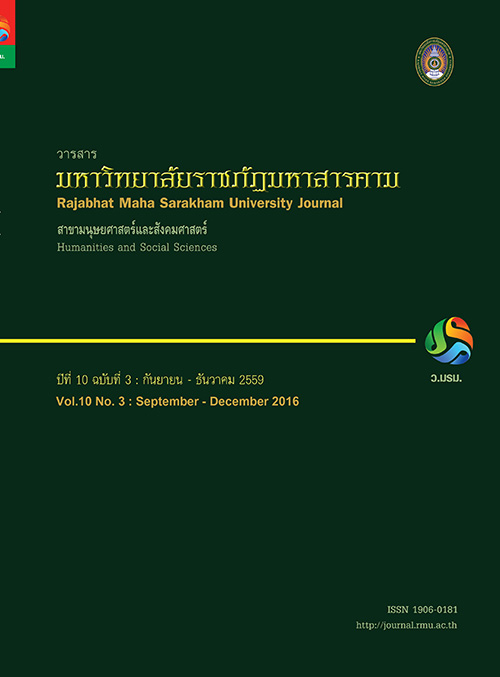ขบวนการเคลื่อนไหวทางสังคมในการจัดการป่าชุมชน: กรณีศึกษา ป่าชุมชนโคกหินลาดและป่าชุมชนโคกใหญ่ จังหวัดมหาสารคาม;Social Movement in the Community forestry Management Case Study of Koke Hin Lard and Koke Yai Communities Forest, Maha Sarakham
Main Article Content
บทคัดย่อ
การวิจัยในครั้งนี้มีวัตถุประสงค์ 1) เพื่อศึกษาปรากฏการณ์การเคลื่อนไหวทางสังคมของป่าชุมชนโคกหินลาดและป่าชุมชนโคก
ใหญ่ 2) เพื่อศึกษารูปแบบและยุทธวิธีของการจัดการพื้นที่ป่าของป่าชุมชนโคกหินลาดและป่าชุมชนโคกใหญ่เครื่องมือที่ใช้ในการวิจัย
ประกอบด้วย แนวคำถามประกอบการสัมภาษณ์แบบสังเกต เครื่องบันทึกเสียง เครื่องบันทึกภาพและแบบจดบันทึก ส่วนวิธีการเก็บ
รวบรวมข้อมูล ศึกษาจากเอกสารและภาคสนาม ใช้วิธีการสัมภาษณ์แบบไม่เป็นทางการ การสัมภาษณ์เชิงลึก การจัดเวทีแลกเปลี่ยน
เรียนรู้ การสนทนากลุ่มย่อย ผลการวิจัยพบว่า
1. ปรากฏการณ์การเคลื่อนไหวทางสังคมของป่าชุมชนโคกใหญ่และป่าชุมชนโคกหินลาด พบว่า การเคลื่อนไหวดังกล่าวเกิดขึ้น
จากปัจจัยเชิงโครงสร้าง ซึ่งเกิดจากการผลักดันยุทธศาสตร์การพัฒนาอุตสาหกรรมและนโยบายการพัฒนาภาคอีสานของรัฐบาล
รวมถึงโอกาสทางการเมอื งและทางสังคมที่เปดิ ชอ่ งใหป้ ระชาชนไดแ้ สดงออกทางการเมอื งที่ไมเ่ คยมมี ากอ่ น นอกจากนัน้ ปจั จยั เชงิ บริบท
พื้นที่ ได้แก่ การจับจองที่ดินในเขตป่าของนายทุนและชาวบ้าน การจัดทำโครงการปลูกป่าสาธิต ได้กลายเป็นปรากฏการณ์ที่สำคัญ
ของการลุกขึ้นมาต่อสู้ เรียกร้อง และเคลื่อนไหวทางสังคม ส่วนแนวคิด หลักการ และรูปแบบของการจัดการพื้นที่ป่าของชุมชนป่าโคก
หินลาด และชุมชนป่าโคกใหญ่ พบว่า ในช่วงแรกของการเคลื่อนไหวทางสังคม มีการยื่นหนังสือร้องเรียน การรวมกลุ่มคัดค้าน การเดิน
ขบวน การชุมนุมประท้วงการกดดัน ภายใต้ยุทธวิธีตามช่องทางระบบการเมืองปกติ ยุทธวิธีการขัดขวาง ท้าทายระบบการเมืองและ
ยุทธวิธีวัฒนธรรมชุมชนนิยม ซึ่งการเคลื่อนไหวดังกล่าวนำมาสู่การโต้ตอบจากกลุ่มเป้าหมายที่เป็นภาครัฐ เอกชน และชาวบ้านทั่วไปใน
หลายลักษณะ เช่น การยอมรับ การร่วมมือ การขัดแย้ง การประนีประนอม การต่อรอง และการช่วงชิงอำนาจ
2. รูปแบบและยุทธวิธีที่ใช้ล้วนเป็นขบวนการเคลื่อนไหวทางสังคมแนวใหม่ เนื่องจากมีรูปแบบที่แตกต่างจากเดิม ที่มีการ
เคลื่อนไหวเพื่อให้เกิดการเปลี่ยนแปลงแก่สังคมส่วนรวมมากกว่าเพื่อกลุ่ม องค์กรของตนเท่านั้น และในช่วงหลังของการเคลื่อนไหวทาง
สังคม แบ่งรูปแบบการเคลื่อนไหวออกเป็น 2 รูปแบบ คือ รูปแบบแรกโดยผู้นำชุมชน เป็นแกนนำในการอนุรักษ์ป่า สร้างศรัทธาให้ชาว
บ้าน สร้างความไว้วางใจ ประชาสัมพันธ์โดยใช้สื่อพื้นบ้านเพื่อกระตุ้นจิตสำนึก หวงแหนสมบัติของชุมชนผสมผสานกับการใช้
ภูมิปัญญาของชาวบ้าน รูปแบบที่สอง องค์กรภายนอกชุมชนให้การสนับสนุน ส่งเสริมเป็นที่ปรึกษา แนะนำ เพื่อสร้างรูปแบบและแนวทาง
การอนุรักษ์ป่าที่ชัดเจนเป็นรูปธรรม
This research aimed to 1) study social movement phenomena in Koke Hin Lard and Koke Yai
Communities Forest, 2) study concepts, principles, and management models of Koke Hin Lard and Koke Yai
community forests. The instruments used in this qualitative research were a set of interview questions, an
observation form, an audiotape recorder, a videotape recorder, and a note-taking form. Data collection
included reviews of documents & related literature and field works using both informal and in-depth interviews,
knowledge-exchange forums,and small-group discussion.
Findings of the study reveal the following:
1. The social movement phenomena in Koke Hin Lard and Koke Yai Forest Communities resulted
from the structural factors such as the government’s strategic drives for industrial development and its policies
to develop the Northeast, including social and political opportunity for the public to voice their opinions as
never occurred in the past. The area-based contextual factors such as investors’ and villagers’ invasion of
the forest land, as well as forest-replanting demonstration projects, have been significant public phenomena
of social demands and movements. Regarding concepts, principles and management models of Koke Hin
Lard and Koke Yai Forest Communities, the study revealed the following activities during initial periods of
social movements: submitting petitions, participating in group protests, protesting rallies, and pressuring
mobs organized under normal political channels of communication. However, strategies for obstructing and
challenging the political system, as well as strategies for popular community culture, usually resulted in
responses from the target group, the government sector and the villagers in different forms: i.e. acceptance,
cooperation, conflict, reconciliation, negotiation, and power usurpation.
2. The concepts, principles and models used were all modern forms of social movements, obviously
different from the traditional ones, which had focused on movements to cause changes to the general public
rather than for only their own group or organization. The current social movements can be classified into two
types: the first one is led by the community leader as the key man in forest conservation, building trust and
faith among villagers, using local or media for public relations to stimulate public conscience and care for
their community properties in combination with local or folk wisdom; the second form or model is based on
external support from outside the community, serving as consultants or advisors in constructing the model
and establishing clear and concrete guidelines for forest conservation.
Article Details
1. บทความที่ลงตีพิมพ์ทุกเรื่องได้รับการตรวจทางวิชาการโดยผู้ประเมินอิสระ ผู้ทรงคุณวุฒิ (Peer Review) สาขาที่เกี่ยวข้อง อย่างน้อย 3 ท่าน ในรูปแบบ Double blind review
2. ข้อคิดเห็นใด ๆ ของบทความที่ลงตีพิมพ์ในวารสารมหาวิทยาลัยราชภัฏมหาสารคาม นี้เป็นของผู้เขียน คณะผู้จัดทำวารสารไม่จำเป็นต้องเห็นด้วย
3. กองบรรณาธิการวารสารมหาวิทยาลัยราชภัฏมหาสารคาม ไม่สงวนสิทธิ์การคัดลอกแต่ให้อ้างอิงแสดงที่มา


